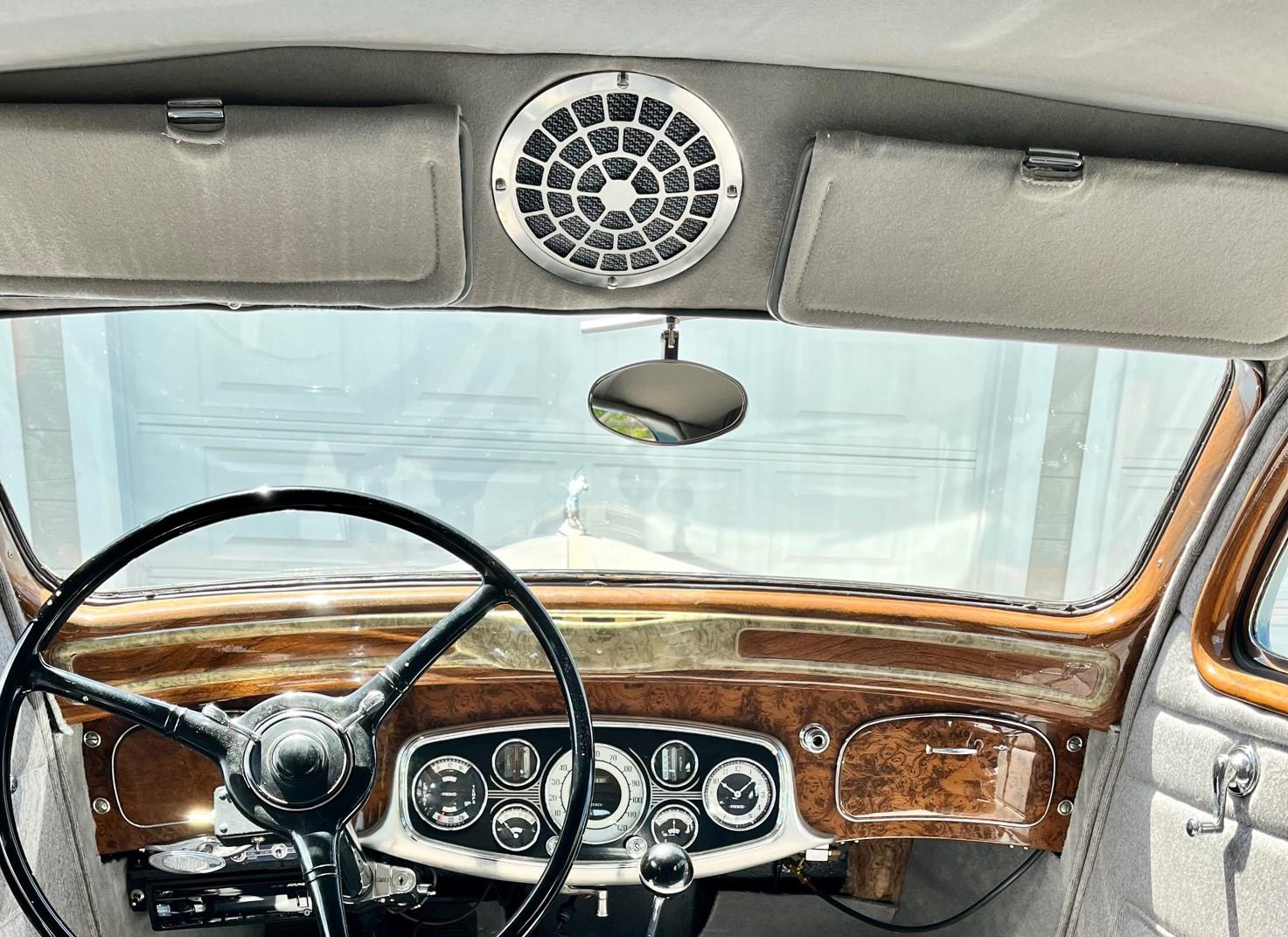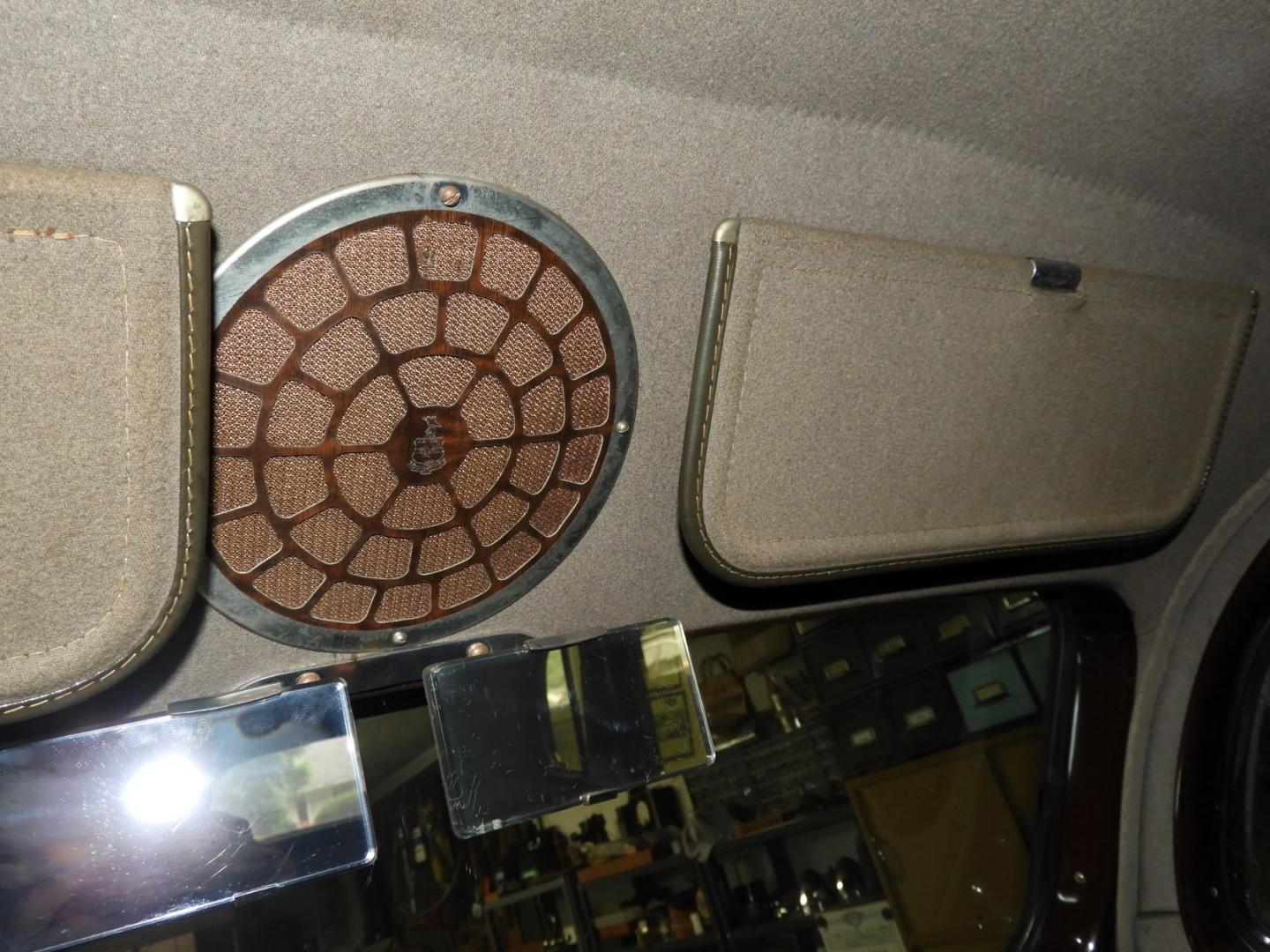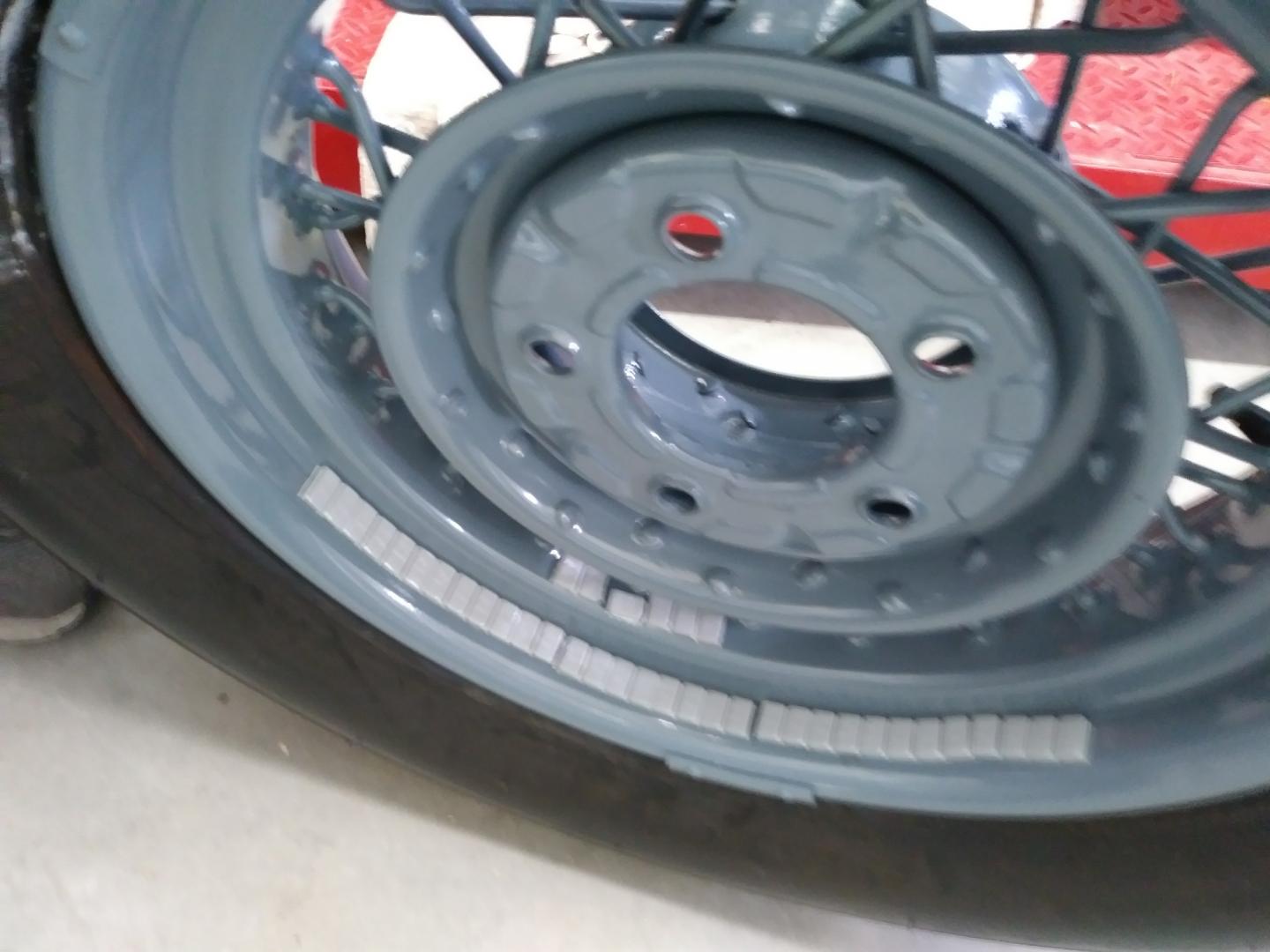- Home
- About Us
- Join/Renew
- Member Benefits
- Member Pages
- Log In
- Help
- Museum Store
Another member was looking for a 37 grille in June and found one. The pictures of mine and the original are 1935. Some back and forth with him made me think the 37 might have had a different mounting scheme instead of the 4 mounting screws. You might contact Steve to see what he found, you can find his contact info via a search for “speaker” on the forum.
Based on another picture of an original I believe the original grille was painted brass. I saw a youtube of another restored Pierce with everything chrome plated. I suspect that wasnt the original finish but dont know. I made mine from aluminum and sanded it to resemble brushed stainless. The grille is dished out slightly so it needed to be formed a bit with a metal that wouldnt spring back too much. The outer rings are stainless. The fabric behind the grille was a radio speaker cloth typical of the era. There are some vendors of repro speaker cloths with a Google search. Lots of browns with metallic threads interwoven.
I have laser cutting CAD files to reproduce the grille, the pattern is very close but the outer rings are laser cut and glued rather than rolled. Better if you can find an original but if not this is an alternative.

An original:

Mine is an Eight but I believe it serves the same function on a 12. It is set up to bypass the oil filter if it becomes clogged.
You can find information doing a keyword search on the PAS service bulliten directory. Meanwhile, I have had two issues with zero oil pressure, one is the floto screen (the oil pump inlet screen) plugged with junk, or the oil pressure regulator valve piston stuck. The former was from accumulated junk, the second (brand X) a rebuilt oil pump with a burr left in the regulator sleeve. Could possibly be the oil pressure relief spring broken from corrosion. These entail dropping the pan to inspect.
You could verify that the gauge isn’t the issue first. Unscrew the line from the engine oil port going to the gauge and pressurize the gauge with an air compressor and regulator. I would set the regulator for no more than 40 psi to avoid damaging the gauge.
I’ve converted to LED for all rear lights. For headlights I use halogens which I’ve found to be as bright or brighter as conventional 50cp with the same current draw as the original 32 cp. I didn’t use LED’s for headlights as the diodes in the bulb are spread out and all can’t be placed directly in the focal point of the reflector. I don’t know if that actually makes a tangible difference. I buy from Classic and Vintage bulb from Australia, he has a wide selection, a decent catalog that explains and good quick service.
Check with Dave Murray of Blonder Murray, they had made repros a few decades ago, maybe he still has some. John Cuslak and eBay if course.
I would be very careful about dealing with SMS. They supposedely have a mill that weaves to custom orders. May be alright if you don’t mind spending a couple years without communication on your prepaid order. I felt lucky to get a refund after months waiting for material that they originally said was in stock, then after weeks of getting the run around said they had to make it.
They may be the only game in town at this point for anything besides plain broadcloths. Review the BBB complaints before ordering.
Greg, yup it is a bizarre system that relies on the cups getting gas sloshed into them trapping vapor bubbles in the tiny tubes that the weight of fuel in the cup then slowly forces tiny bubbles out under the sending unit, and then the bubbles float up and go through the very tiny hole to recharge the trapped vapor inside the vapor dome. If a perfect seal that system isn’t needed. With all the posts and discussion over the years it seemed near impossible to get a good seal so “just in case” while the car was apart I installed a tiny DC aquarium pump that with a switch under the dash bubbles air under the vapor dome.
There have been many comments about getting the gauge to work for a little while then goes goofy. My theory is that if there is a vapor leak in the line connections to the gauge, then sitting with a full tank of gas will slowly fill the sending unit air tube with liquid fuel to the level of the tank. As the fuel level drops from being driven it takes a long time for that trapped fuel in the sender tube to drop, so then if the tank is refilled within a short period such as during a day’s tour it can end up forcing some fuel slightly above the tank and into the line, and once the tiny air line has bits of fuel in it, capillary action will screw-up the readings and its all over unless the line is disconnected and back flushed with air.
Not that the electric gas gauges don’t have problems. I’ve chased down problems on two other cars the last couple months, one still unexplainable.
Im not too familiar with 1920’s but are your headlight bulbs 21 candlepower? 32 cp became standard in the ’30’s and 50’s were available but illegal in many states because of oncoming driver glare. A quaint notion by the 80’s when being faced with four searing halogens. 50s though draw a lot of power.
A question on dim headlights is whether the reflectors are good, original silver can be polished but tarnishes quickly. UVIRA did a coating that maintains its reflectance for decades, I don’t know if they are still around. If good reflectors aren’t in the cards maybe auxiliaries are a good choice but bumper mounted is pretty low and can create a lot of glare for oncoming, witness jerks who drive around with their fog lamps lit continuously on clear nights.
I use Classic and Vintage bulbs in Australia, he has a good catalog and selection of LED, halogen and original tungsten. I have a big inventory of 50 cp tungsten bulbs gathered years ago but they draw too much power. I used to mount a 50 on one side and a 32 on the other. I have gone to 6v halogen headlight bulbs which draw about the same power as a 32 cp tungsten but are about as bright as later sealed beams. I should add that drawing more power than the generator can keep up with isnt necessarily a problem if the battery is in good shape and you aren’t driving all night, just disconcerting on a dark night seeing the ammeter on the negative side. A battery with a 10 amp deficit should go for many hours.
I debated on LEDS for headlights. What bugged me about them was the multiple LED diodes in the bulbs are spread away from the focal point so the focus is thrown off. I don’t know if that is actually noticeable, and perhaps minor in the scheme of things. I have replaced all the other bulbs with LEDs.
Looking fantastic! You must have a very steady hand.
Looking through the tune-up guide I see the confusion factor is the backwards way it talks about advance. It says “Manual advance: 33 degrees (engine – maximum). Consists of retard operated by pulling out button on dash. Used for hand cranking or heavy pulling“.
The ’35 owners manual states “the spark control button is provided to meet unusual conditions. In its innermost position, the spark timing is held “advanced” and, under normal driving conditions, it should remain in that position. There are conditions which may arise that require “retarding” the spark. This is accomplished pulling the the button out until the desired position is reached. Evidence that the spark is advanced too far is indicated by “pinging” in the engine. However, this is not harmful to the engine. A slight “ping'” indicates that maximum power is being obtained from the engine. There are many causes for “pinging”, the more common causes of which are, inferior grades of gasoline and heavy pulling on steep grades.
The confusion arises from calling the 33 degrees “maximum manual advance”, when it would be clearer to call it 33 degrees maximum manual retard. If set for maximum advance with the knob pushed all the way in and considered “normal driving conditions” 33+5 degrees 38 degrees BTDC would be a ridiculous amount of advance. It would likely try to kick backwards trying to crank it. The 33-5 = 28 degrees of retard ATDC with the spark control pulled all the way out is pretty extreme also. At that setting maybe kerosene wouldn’t knock if you could get it to fire at all.
Yes, that’s the way I understand it. The spark control is used in case one gets a batch of low octane fuel and it starts to knock. In the case of a 1930’s car that probably means on the order of 65 octane or less. With 87 octane being the norm the idle timing can be advanced a bit, I use 10 degrees BTDC instead of 5. It will add a very slight amount of power, a very slight improvement in fuel economy, more advance than that not much. Heat added to the coolant will go down slightly and exhaust gas temperature will also, reducing valve recession tendencies, again very slightly. Back in the ’70’s California added devices to retard the spark to reduce pollutants and there were complaints about overheating and reduced power. My 49 state 1966 Chrysler had timing of 12.5 degrees BTDC and the California version was actually 5 degrees ATDC. If all is well it would be surprising to have any knock and any need to touch the spark retard on a ’30’s. My Packard with 6.5 compression instead of 5.5 does not have a manual spark retard at all.
Nope, I tried turning the plug a while back, but seemed very stuck after some soaking and I am paranoid about applying a lot of brute force to anything on the manifold. The butterfly itself is very free and moves very easily, oddly enough.
Rather than guess at what parts are correct or not you could just stick something down the port with everything removed and measure how deep it is to hit the ledge that the piston head sits against. A long bolt or threaded rod a little smaller in diameter than the piston with a nut at one end could be used to bottom the bolt in the hole, then turn the nut until it touches the end where the regulator nuts bear against the outside of the block. That gives you total depth. Then measure the length of the piston and everything except the spring that goes into the hole with adjustment screw all the way out to see if the piston has room to move out without the spring. A wire with a very short hook bent 90 fegrees at the end could be used to find the depth of the start of the bypass slot. This would determine if something is too long to let the piston open enough.
Assuming there is then the spring might be too stiff or too long. With the measurements of the hole and pieces including some spring dimensions I could calculate.
You can get zinc additive and not have to resort to such thick oil. Ab Jenkins was using 20 straight weight on his speed runs in the hot desert of Bonneville. 20 straight is a fair bit thinner than 10W30 at high temperatures. At low temperatures the viscosity for any of them is dramatically thicker than needed to maintain oil film thickness.
Good that you found the piston is free. I am unclear though, before it still had high oil pressure with piston in but the spring removed? Now it goes to zero pressure with spring and piston removed, indicating the bypass is clear without the piston. Not sure how to interpret that. Will it still read high if you put the piston back in but leave the spring out?
I assume both the pressure relief valve and port reading the pressure is downstream of the oil pump fed by the same oil gallery system that feeds the bearings, so I don’t think the pump would be deadheading.
I echo Carl’s concern that the bearings might be set up too tight. Extreme tight clearances make for a quiet engine until the bearings fail. 20W50 oil is thick and contributing to the high oil pressure, although probably not a primary cause. My 35 manual recommends nothing thicker than 30 straight weight, Packard recommended 40 only if average temperature exceeded 90F. These engines were designed to use thinner oils hence the large bearing and piston surface areas. 20W50 provides greater load capability that isnt needed but increases bearing temperatures, not good for babbit. Multi vis is good, but I would use 10W30 or at most 10W40. 10W30 is thicker than 30 straight weight at temperatures above 210 F that the local bearing temperatures will see.
I’m not sure how to interpret the detail in the circle, presumably the oil gallery fed by the oil pump is the channel at the right perhaps rotated at 90 degrees for illustration purposes, i.e I imagine it is a horizontal channel cast in the block. At any rate the problem could be the piston is stuck in the closed position as shown in the illustration without access to push on the front side. It would be difficult to pull out to see if it is free or stuck. Perhaps someone has a dissasembled a piston and could take a picture to see if there is some way to get a hold of the backside of the piston with nuts and springs removed to try and pull out.
If it is stuck perhaps a generous soak sprayed into the back side with rust cutting penetrating oils such as Kroil could loosen it. Perhaps additives in the oil such as Rislone, seafoam etc to work on the deposits from the oil side and temporarily use a light vicosity oil to reduce the excess pressure when running, just start it and run briefly at idle once a day to work the oil in. With 90+psi pushing it would probably come loose very suddenly, if that is the problem of course.
Did you check that the oil pressure regulator piston wasn’t stuck closed so it doesn’t allow any oil to bypass? I’ve had a pressure regulator on a brand X stuck on a burr the other way with 0 oil pressure.
Thanks Bill, that explains it. The original owner of mine must have had problems with it and tried to modify it before giving up and installing a manual choke. In my box of parts when I got it was a manual choke bowden cable and a bracket on the air cleaner to mount it. The car was from Wisconsin so choking a pretty serious issue! It also had a gasoline fired Southwind heater. My Dad had a block heater for his Studebaker to keep it warm all night when we lived there in the ’60’s.
Interesting idea, never heard of these but looking at the website it doesn’t appear they are viable. Quoting from their website:
Unlike some companies that recommend using their compounds in small passenger vehicles, we know from extensive testing, suspension dynamics, and a variety of other elements of physics that you cannot guarantee success or improved performance. Having produced Counteract for over 25 years, and working with large manufacturers and suspension specialists, we have only been able to achieve a 74% success rate in passenger vehicles. From our research and testing, the largest culprit in the passenger vehicle segment that prevents the product from performing at its best is due to the soft suspension of most cars.
Elsewhere on the site they say it has worked on “classic” cars which of course is a general term which nowadays means any car with a body shell more than 20 years old. They say it has worked because of their stiffer suspension, which makes me wonder what “classic” era they are talking about. 1910’s?
At any rate the installation and removal process looks to me like it is for tubeless only (which doubles the curiosity about what classic cars could they possibly be talking about?) Modified hot rods or race cars with bone shaking suspensions?
Thanks, it is pretty interesting.
I got my tires back and balanced with a lot of small weights, a bit crazy but at least they are on the car now.

